Bacalar Lagoon, often called the “Lagoon of Seven Colors,” is a hidden gem on Mexico’s Yucatan Peninsula. If you’re dreaming of crystal-clear turquoise waters surrounded by lush jungle, Bacalar should be at the top of your travel list. You might even be wondering, like many first-time visitors, “Are there crocodiles in Bacalar Lagoon?”. This is a valid question for any stunning natural body of water, and we’ll address it, alongside everything else you need to know to plan your perfect trip to Bacalar Lagoon, Mexico.
As someone who has explored every corner of the Yucatan Peninsula and beyond, I’m excited to share my insights into why Bacalar Lagoon is a must-visit destination. While Cancun, Cozumel, and Tulum are popular choices, Bacalar offers a unique and less crowded experience. It’s a place where you can truly connect with nature, enjoy breathtaking scenery, and unwind in a tranquil setting. Let’s dive into what makes Bacalar so special and answer all your burning questions.
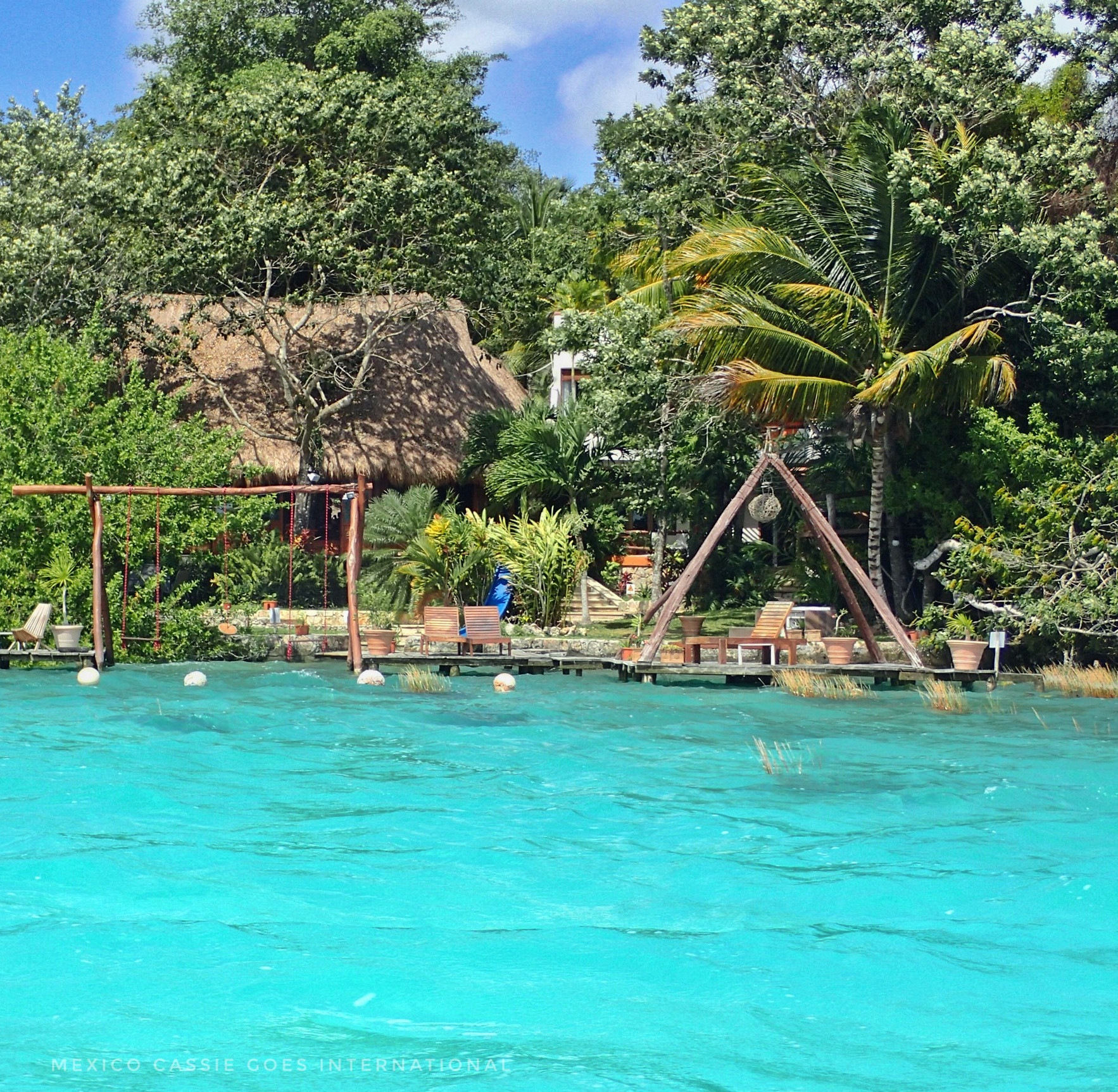 swings over water – turquoise water, jungle setting
swings over water – turquoise water, jungle setting
Image: Enjoy the iconic swings over the stunning turquoise waters of Bacalar Lagoon, Mexico, surrounded by lush green jungle.
Bacalar Lagoon: Key Highlights
Bacalar Lagoon offers a unique blend of natural beauty and laid-back charm. Here are some highlights you can expect:
- Swimming in Unparalleled Beauty: Imagine immersing yourself in the incredibly clear waters of the lagoon, with vibrant shades of blue all around you, framed by dense, green jungle.
- Exploring by Boat: A boat tour is essential to discover hidden gems like the famous Pirates’ Canal and fascinating cenotes within the lagoon system.
- Iconic Water Swings: Experience the quintessential Bacalar moment by relaxing on swings directly over the lagoon’s edge at a beach club or balneario.
- Affordable Lakeside Luxury: Indulge in a lakeside hotel experience that offers exceptional value, with options ranging from budget-friendly to more luxurious stays.
- Crocodile Concerns (Debunked): Rest assured, while crocodiles are present in the Yucatan Peninsula, encountering them in Bacalar Lagoon is highly unlikely if you stay informed and exercise common sense.
Understanding Bacalar Lagoon: Lake vs. Lagoon vs. Beach
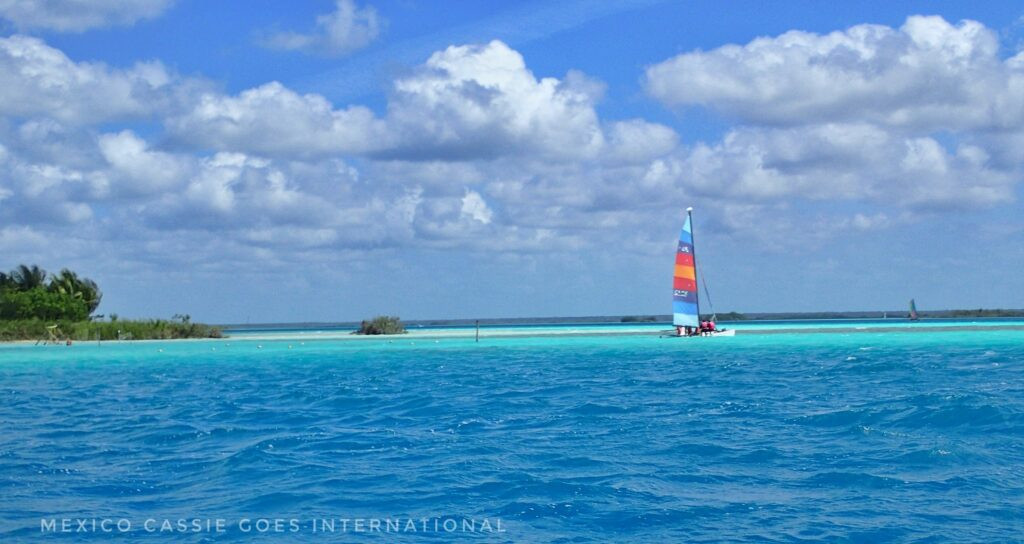 different shades of blue water – sailing boat in distance
different shades of blue water – sailing boat in distance
Image: Sailboat gently gliding on Bacalar Lagoon, Mexico, showcasing the diverse shades of blue in its crystal-clear waters.
It’s common to hear Bacalar referred to as “Laguna de Bacalar” in Spanish, meaning lagoon, and affectionately nicknamed “La Laguna de 7 Colores,” the Lagoon of 7 Colors. However, geographically, Bacalar is actually a freshwater lake, not a saltwater lagoon or a beach destination.
Freshwater Origins: Bacalar Lagoon is fed by underground rivers and cenotes, characteristic sinkholes of the Yucatan Peninsula. Unlike much of the region, Bacalar is a significant freshwater lake. The peninsula’s limestone bedrock filters the water, contributing to the lagoon’s remarkable clarity and the bright, stunning blue hues are a result of the white limestone bottom reflecting sunlight.
Part of a Larger System: Looking at a map reveals that Bacalar Lagoon is part of a network of interconnected lakes that eventually link to the Caribbean Sea. The main body of water, Laguna de Bacalar, stretches approximately 42 kilometers (26 miles) in length and is around 2 kilometers (1.2 miles) wide.
Lakeside, Not Beachfront: While Bacalar is not located directly on the Caribbean coast, it boasts numerous lakeside “balnearios” (beach clubs) that provide beach-like access and amenities along the shores of the Laguna de Siete Colores. If you’re seeking traditional ocean beaches, destinations like Cancun, Tulum, or the quieter Yucatan beaches on the Gulf Coast are better suited.
Bacalar Pueblo Magico: Bacalar is also the name of the charming town situated on the edge of the lagoon. It holds the designation of “Pueblo Magico” (Magic Town), awarded by the Mexican government to recognize towns that offer visitors a unique cultural and visually appealing experience.
Family-Friendly “Beach” Experience: Even though it’s not a coastal beach, Bacalar Lagoon offers a very family-friendly “beach” environment due to its shallow, calm waters, making it arguably one of the best family-friendly beach alternatives in Mexico.
Saltwater or Freshwater? The Water Composition of Bacalar Lagoon
Bacalar Lagoon is unequivocally freshwater. Its source is the extensive network of cenotes and underground rivers that permeate the Yucatan Peninsula. In fact, it’s recognized as the second-largest freshwater lake in Mexico, following Lake Chapala in Jalisco.
Crocodiles in Bacalar Lagoon: Addressing the Concerns
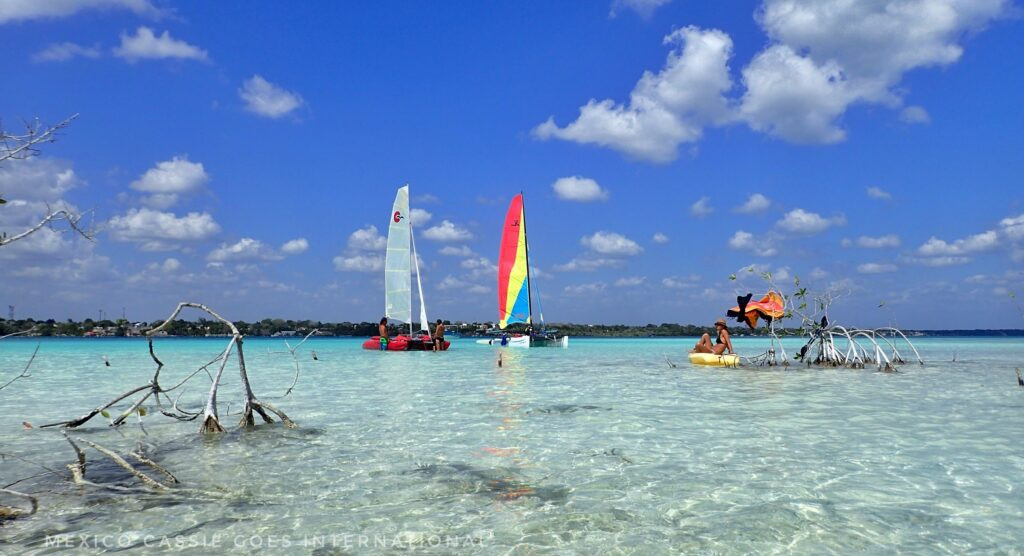 shallow clear water, three boats on water
shallow clear water, three boats on water
Image: Boats gently float on the shallow, incredibly clear water of Bacalar Lagoon, Mexico, inviting visitors to explore its beauty.
The question of crocodiles in Bacalar Lagoon is frequently asked, and for good reason. While for a long time, it was believed that crocodiles were absent from Bacalar Lagoon, there have been occasional, more recent reports of sightings. Newspaper articles and local accounts sometimes mention crocodile presence, although photographic evidence is not always provided.
Crocodiles in the Yucatan Peninsula: It’s important to acknowledge that crocodiles are indeed native to the Yucatan Peninsula. They can inhabit various bodies of water, including cenotes and even coastal beaches in both Yucatan and Quintana Roo states. Personal experiences, like swimming in a cenote known to have a crocodile, highlight their presence in the region.
Low Risk, Not Zero Risk: While crocodile sightings in Bacalar Lagoon are not common, and there have been no reported crocodile attacks, it’s not possible to definitively state that they are entirely absent.
Ecoparque Bacalar Signage: The newly established Ecoparque Bacalar features signs specifically warning visitors about potential crocodile sightings. These signs also emphasize the crucial message of not feeding crocodiles, a practice that can alter their natural behavior and increase risks to humans.
Other Wildlife in Bacalar Lagoon: Beyond Crocodiles
Bacalar Lagoon is teeming with life beyond just the occasional crocodile sighting.
Diverse Aquatic Life: The lagoon is home to a variety of fish species and, remarkably, stromatolites. Birdlife is also abundant throughout the Bacalar Lagoon area.
Stromatolites: Ancient Living Fossils
Stromatolites are truly extraordinary – they are fossils of some of the earliest life forms on Earth, dating back billions of years. These organisms played a pivotal role in oxygenating Earth’s atmosphere, making the evolution of life as we know it possible. Bacalar Lagoon is one of the few places on the planet where these rare formations still exist. They have been around for approximately 3 billion years.
Crucial Conservation: It’s absolutely vital to protect these delicate and scientifically important stromatolites. Please do not touch them if you encounter them in Bacalar Lagoon.
Swimming in Bacalar Lagoon: Is it Safe and Enjoyable?
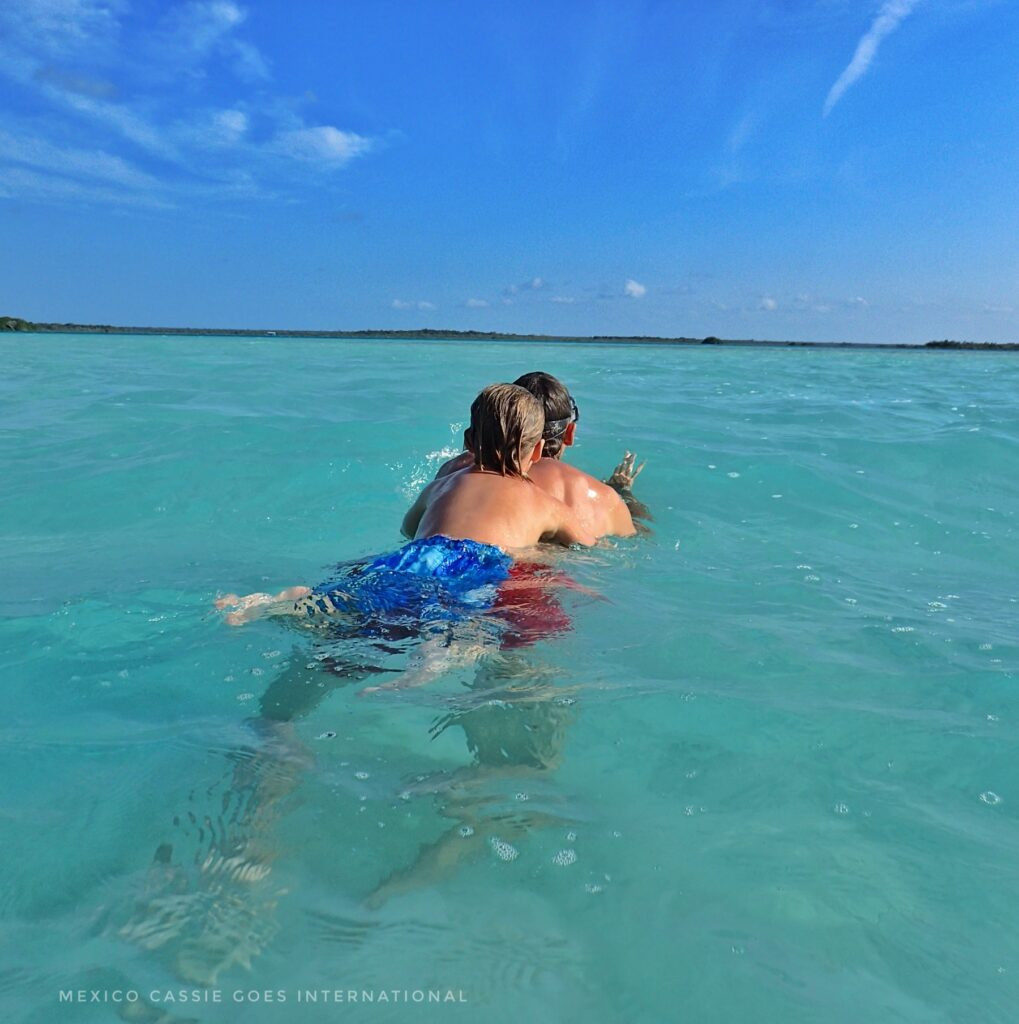 man with child on his back swimming away from camera
man with child on his back swimming away from camera
Image: A father and child enjoy a swim in the inviting waters of Bacalar Lagoon, Mexico, showcasing its family-friendly appeal.
With the crocodile question addressed, let’s focus on swimming in Bacalar Lagoon. The answer is a resounding yes! Swimming in this breathtakingly beautiful lagoon is an unforgettable experience. The vibrant colors and crystal-clear water are simply mesmerizing.
Perfect for Families: Bacalar Lagoon is particularly well-suited for families. The shoreline areas offer shallow waters, creating safe and enjoyable swimming conditions for children.
Common Sense and Local Advice: As with any natural environment, exercising common sense is key. Inquire at your hotel, local bars, or ask residents for any current local advice regarding swimming areas. Swimming where locals swim is generally a good practice.
The Lagoon of Seven Colors: Unveiling the Mystery
Bacalar Lagoon earns its nickname, “Laguna de 7 Colores,” from the astonishing array of blue hues visible in its waters. This captivating phenomenon is due to varying water depths and the presence of four cenotes within the Bacalar Lagoon system. These cenotes contribute to the diverse shades of blue, creating a truly stunning visual spectacle.
Is Bacalar Lagoon Worth Visiting? Responsible Tourism in Paradise
Bacalar Lagoon is undoubtedly a destination worth experiencing. Its unparalleled natural beauty and tranquil atmosphere make it a standout location in Mexico.
Fragile Beauty and Responsible Travel: However, it’s crucial to acknowledge the vulnerability of pristine environments like Bacalar Lagoon. As travelers and tourists, we have a responsibility to treat every destination with respect and consider our impact. Local experts and residents have noted changes in the lagoon’s water color in recent years. Events like Tropical Storm Cristobal in 2020 brought prolonged periods of murky water to Bacalar, highlighting the delicate balance of the ecosystem. Each influx of water and storm event can cause changes that are increasingly slow to reverse.
The Challenges of Mass Tourism: Like other once-hidden gems such as Tulum and Holbox, Bacalar faces the challenges of growing tourism without adequate infrastructure to support it sustainably. Mass tourism can strain resources and impact the environment.
Mindful Exploration: It’s understandable to want to experience Bacalar’s beauty – the author included! As traditional Mexican Caribbean destinations become more crowded, seeking out “the next cool spot” is natural. However, if everyone flocks to the same place, the impact on small towns like Bacalar can be significant. The aim isn’t to discourage visits, but to encourage responsible and respectful tourism.
Exploring Alternatives: If concerns about tourism impact weigh on your travel choices, consider exploring quieter areas of the Costa Maya or the beautiful beaches of the Yucatan Gulf Coast. We can all enjoy beautiful places as long as we travel thoughtfully and respectfully.
Sargassum Seaweed: Not a Bacalar Problem: If you are concerned about sargassum seaweed, which has affected many Caribbean beaches, you can relax when planning a trip to Bacalar Lagoon. Sargassum is seaweed, and since Bacalar is inland, it is not affected by this coastal issue. However, sargassum remains an environmental challenge for Quintana Roo’s coastal areas.
Simple Steps to Be a Respectful Bacalar Lagoon Visitor
- Sunscreen Awareness: Refrain from wearing sunscreen or lotion when swimming in the lagoon. Chemical sunscreens can harm the delicate ecosystem. Opt for reef-safe, biodegradable sunscreens if needed and apply them well in advance of entering the water.
- Wednesday Lagoon Rest: Avoid swimming or taking boat tours on Wednesdays. Local efforts are underway to give the lagoon’s fragile ecosystem a chance to recover by minimizing human impact on Wednesdays. Participate in this initiative.
- Leave No Trace: Do not litter anywhere in Bacalar or around the lagoon. Dispose of trash responsibly.
- Conserve Resources: Be mindful of resource consumption, including water and energy, during your visit.
⭐️ For more packing tips and responsible travel essentials, check out a detailed packing list for Mexico.
A Brief History of Bacalar: Echoes of the Past
The name Bacalar originates from the ancient Maya city Siyan Ka’an Bakjalal, meaning “Place surrounded by reeds where the sky is born.” Interestingly, there’s also the Sian Ka’an Biosphere Reserve near Tulum, sharing a connection to this name.
Bacalar’s history is rich and dates back centuries. The Spanish conquistadors first seized Bacalar in 1543, marking it as the earliest Spanish-held city in this part of the peninsula. In 1545, the Spanish established the town of Salamanca de Bacalar.
The interconnected waterways leading to the sea made Bacalar a strategic point for pirates and traders. To defend against piracy, the San Felipe Fort was constructed in 1725.
Location of Bacalar Lagoon: Getting There
🧭 Bacalar is situated in the southern part of Quintana Roo state, Mexico, close to the Belize border. It’s approximately a 2.5-hour drive from Tulum and about 40 minutes from Chetumal.
Directions to Bacalar Lagoon
✈️ Air Travel: The closest airports are Chetumal International Airport (CTM) and Cancun International Airport (CUN). Chetumal is closer, but Cancun offers more international flight options.
🚗 By Car: Roads to Bacalar are generally in good condition. Be aware of potholes and “topes” (speed bumps) throughout Quintana Roo. Gas stations can be infrequent, so it’s advisable to keep your fuel tank filled.
🚂 Maya Train (Tren Maya): The highly anticipated Maya Train project is expected to be operational in early 2024, with Bacalar as a key station on the route. This will offer a new and exciting way to reach Bacalar and explore the region.
Driving Distances to Bacalar:
- Cancun: 5 hours 37 minutes (377 km)
- Campeche: 6 hours 15 minutes (420 km) via Calakmul biosphere and ruins
- Mérida: 4 hours 20 minutes (345 km)
- Tulum: 2 hours 30 minutes (210 km)
- Valladolid: 3 hours 30 minutes (264 km)
- Belize City: 2 hours 50 minutes (180 km)
- Chetumal: 40 minutes (42 km)
🚌 By Bus: ADO buses serve Bacalar from various locations in Mexico, including Mexico City (though a long journey), Cancun, and other Yucatan Peninsula cities. Consider flying into Cancun or Chetumal and then taking a bus for a more comfortable trip from Mexico City.
Bus schedules and booking can be found in Spanish on ADO or in English on Busbud.
🚊 Tren Maya: As mentioned, the Tren Maya will include a station in Bacalar, promising to improve accessibility.
🚢 Cruise Excursions: Cruise ships do not directly visit Bacalar. However, if your cruise itinerary includes a stop along the Costa Maya, you may find tours to Bacalar offered as shore excursions.
How Many Days to Spend in Bacalar Lagoon?
A minimum of three days is recommended to fully relax and experience the highlights of Bacalar Lagoon. However, extending your stay will allow for a more leisurely exploration and deeper immersion in the area.
Best Time to Visit Bacalar Lagoon: Weather and Seasons
Image: A child enjoys the shallow waters of Bacalar Lagoon, Mexico, walking along a pier, highlighting its appeal for family vacations.
🔆 November to May is generally considered the best time to visit Bacalar Lagoon, offering pleasant weather. Bacalar is beautiful year-round. January is typically the coolest month, with comfortable daytime highs around 29°C (84°F) and lows of 19°C (66°F).
🌦 June to October are the hottest months and coincide with the rainy and hurricane season. This often means daily rain showers, usually lasting for an hour or so. While hurricanes are rare, tropical storms are more common between August and October. Tropical storms can bring significant rainfall and temporarily alter the lagoon’s water color from its characteristic blues to murkier shades.
High Season: Christmas and Easter (Spring Break) periods are peak tourist seasons in Bacalar. Expect higher prices and book accommodations and tours in advance if traveling during these times.
Top Things to Do in Bacalar Lagoon: Activities and Experiences
Bacalar Lagoon’s main attractions center around outdoor activities that allow you to appreciate its natural beauty and enjoy the water. Relaxation is also a key part of the Bacalar experience, with many places to unwind and soak in the scenery, including the famous water swings.
Accessing the Lagoon:
- Public Balnearios: Balnearios provide public access to the lagoon with basic facilities.
- Beach Clubs, Restaurants, and Hotels: Many establishments offer day passes for lagoon access with added amenities.
- Boat Tours: Explore the lagoon’s highlights on a boat tour.
- Lakeside Rentals: Rent a house or stay in a hotel with direct lagoon access.
Relaxing and Enjoying Bacalar Lagoon at Balnearios
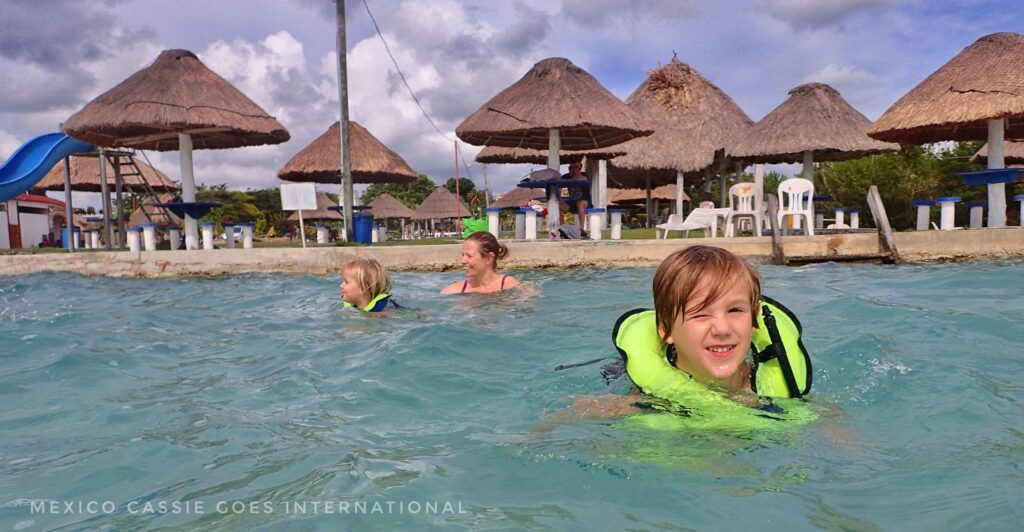 child in yellow life jacket and two others swimming in water with palapas behind
child in yellow life jacket and two others swimming in water with palapas behind
Image: Families enjoying swimming at a balneario in Bacalar Lagoon, Mexico, with palapas providing shade on the shore.
Balnearios are public lakeside spaces offering lagoon access, popular with locals and Mexican tourists. They typically charge a small entrance fee and provide a more local, less luxurious experience compared to private beach clubs.
Balneario Ejidal Magico
Located within Bacalar town, Balneario Ejidal Magico features a long wooden pier, diving platforms, waterslides, hammocks, and water swings. It also has a café serving food.
Balneario Ecologico
Balneario Ecologico offers a quieter, more natural experience. It’s ideal for those seeking lagoon access without extensive facilities or crowds, perfect for a peaceful escape.
Ecoparque Bacalar
Further out of town, Ecoparque Bacalar is a newer park with a 1-kilometer wooden walkway extending over the lagoon. Entrance is around $20 pesos (free for locals).
🐊 Crocodile Signage: Be aware that Ecoparque Bacalar has signs warning about crocodiles in certain areas, particularly sections not ideal for swimming.
Balneario Municipal El Asseradero
Balneario Municipal El Asseradero features a picturesque pier with a thatched palapa at the end. Boat tours can be hired from here. It can sometimes be closed for private events.
Bacalar Lagoon Beach Clubs, Hotels, and Restaurants
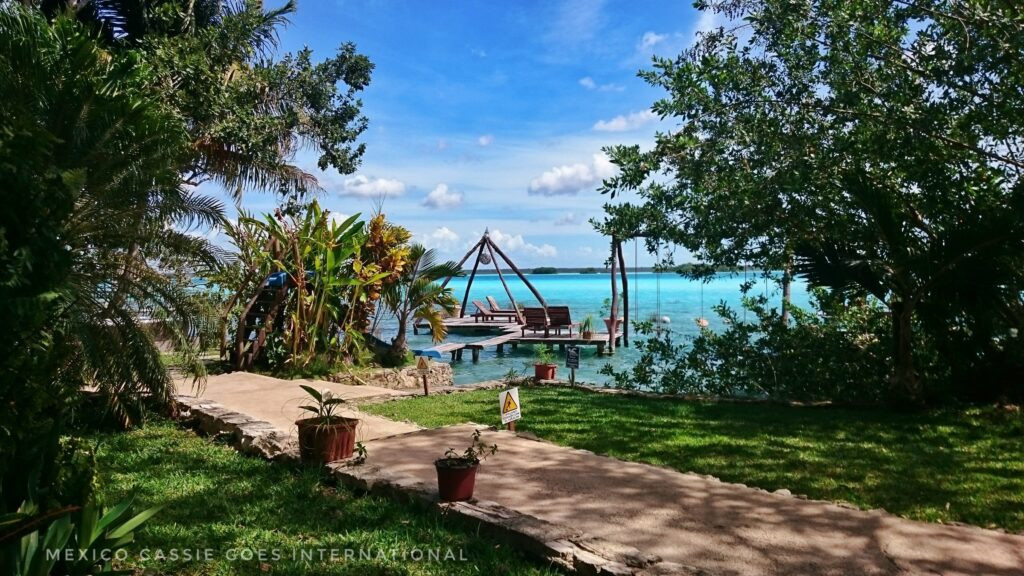 view through trees of a path to perfect blue water with swings over water
view through trees of a path to perfect blue water with swings over water
Image: A serene pathway through trees leading to the breathtaking turquoise waters and iconic swings of Bacalar Lagoon, Mexico.
For a more upscale experience, Bacalar offers beach clubs, hotels, and restaurants with lagoon access. These venues often provide day passes and amenities like loungers, food, and drinks.
→ Enhance your experience by exploring a guide to popular Mexican drinks to enjoy at these locations.
Los Aluxes
Los Aluxes hotel and restaurant, located just outside Bacalar town, offers day passes (around $200 pesos). It features swings over the water, a waterslide, beautiful views, and pier seating. While recent reviews vary, past experiences have been very positive.
La Playita
La Playita is a consistently popular restaurant on the lagoon shore, known for its excellent food and views. Reservations are highly recommended. The restaurant is built on wooden platforms and piers extending over the water.
Bacalar Beach Club
Bacalar Beach Club offers a lively atmosphere with a DJ, infinity pool, loungers, jacuzzi, mixology bar, water activities, hammocks in the water, and kayaks. Private jacuzzis are available for rent (extra cost). Day passes are around $150 pesos.
Cocolitos: Note that Cocolitos beach club appears to be permanently closed.
Boat Tours on Bacalar Lagoon: A Must-Do Experience
Image: A sailboat tour on Bacalar Lagoon, Mexico, gliding across the vibrant turquoise waters, offering a unique perspective of the lagoon.
Even if you are enjoying a relaxing day at the lagoon shore, taking a boat tour is highly recommended to fully appreciate the vast beauty of Bacalar Lagoon.
Tours can be arranged from the municipal balneario, offering options for private “lanchas” (local boats), sailboats, or catamarans. Local boats are typically more affordable.
Typical Boat Tour Highlights:
- Cenote Negro (Cenote La Bruja): A deep cenote reaching about 90 meters (295 feet) deep, perfect for swimming.
- Bird Island (Isla de los Pajaros): A bird sanctuary where docking is prohibited, but birds can be observed roosting.
- Pirates’ Canal (Canal de los Piratas): A shallow, stunningly beautiful area connecting Laguna de Bacalar and Laguna de Mariscal, historically used by pirates in the 1700s. Ideal for swimming and taking photos.
Mexico Cassie Tour Recommendations:
⭐️ Consider booking a private catamaran tour of Bacalar Lagoon, which often includes amenities like wine.
⭐️ Opt for a 4-5 hour lancha tour of Bacalar Lagoon, which typically visits three cenotes, Pirates’ Canal, Los Rapidos, Isla de los Pajaros, two other islands, and two secret rivers, offering a comprehensive experience.
Boat tours are undeniably worth it and are a highlight of any Bacalar Lagoon visit.
Exploring the Cenotes of Bacalar Lagoon
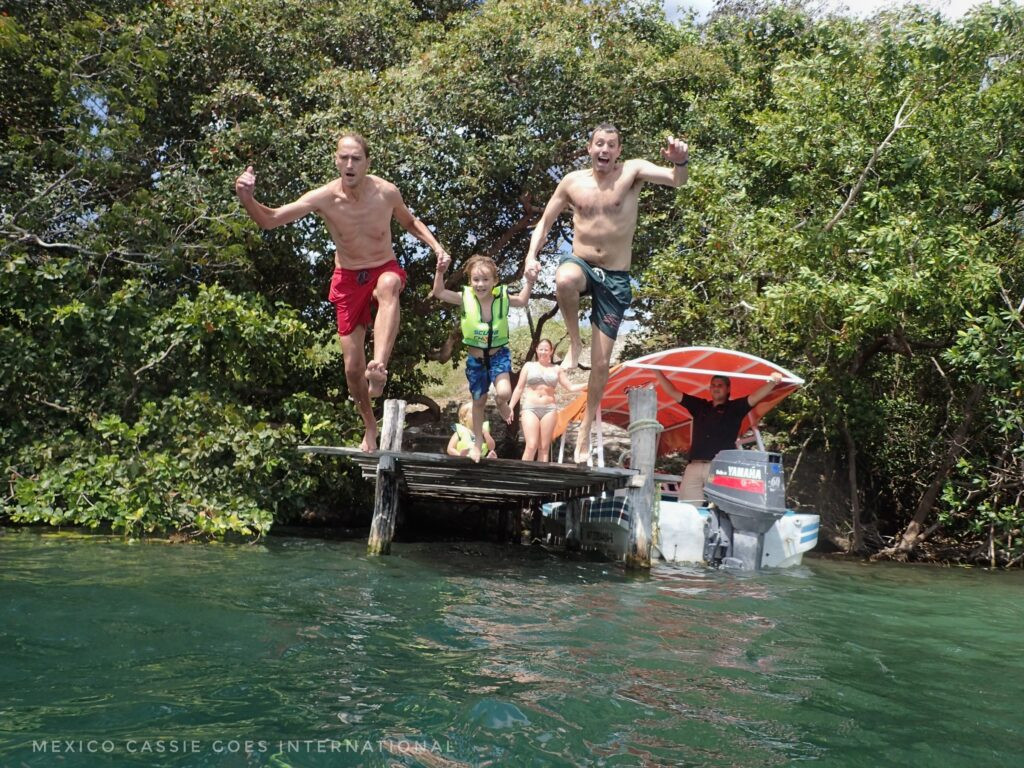 two men holding hands of a child all jumping off a pier into dark water
two men holding hands of a child all jumping off a pier into dark water
Image: Adventurous visitors jump into the deep, dark waters of a cenote in Bacalar Lagoon, Mexico, highlighting the thrill of cenote exploration.
There are four main cenotes in the Bacalar Lagoon area, with three directly connected to the lagoon. These are mature, open cenotes that are popular for swimming and diving.
For cave cenote experiences, the Yucatan region around Mérida or Valladolid offers a greater concentration of cave cenotes to explore.
Bacalar Lagoon Cenotes:
- Cenote Bruja (Cenote Negro): Approximately 130 meters (426 feet) across and 100 meters (328 feet) deep.
- Cenote Esmerelda: Around 70 meters (230 feet) deep.
- Cenote Azul: About 90 meters (295 feet) deep and located just off the main lagoon.
- Cenote Cocalitos: Currently closed. It was known as a location to swim near stromatolites.
Other Water Activities in Bacalar Lagoon
Beyond swimming and boat tours, Bacalar Lagoon offers various water activities:
- Kayaking and Paddleboarding: Rentals are widely available along the lagoon shore.
- Sunrise Paddle Board Tour: Consider a guided paddle board sunrise tour with a floating picnic for stunning lagoon views.
Los Rapidos and Stromatolites: Currents and Ancient Formations
Los Rapidos, the narrowest point of Bacalar Lagoon, is another location to see stromatolites. Reviews are mixed regarding the overall experience. Swimming around the stromatolites is popular, but visitor feedback suggests that the facilities and conservation efforts could be improved. There is an entrance fee, and life jackets are required.
Beyond the Lagoon: What Else to See and Do Near Bacalar?
Fort San Felipe: Pirate History and Panoramic Views
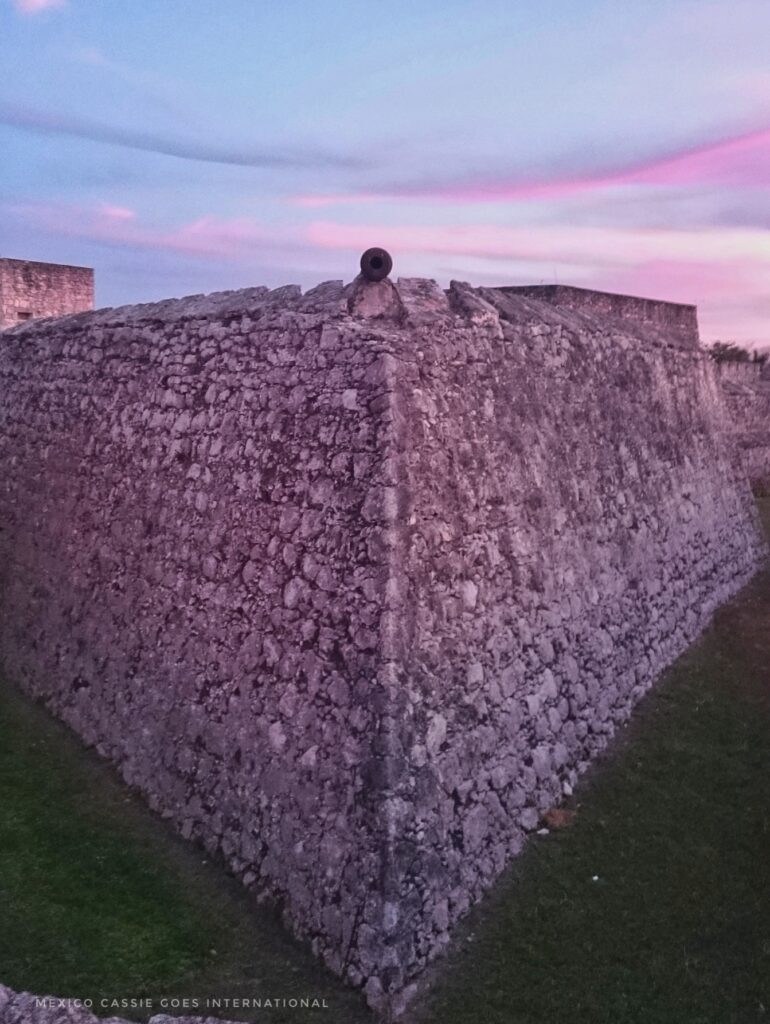 fort walls at dusk, pink sky
fort walls at dusk, pink sky
Image: Fort San Felipe in Bacalar, Mexico, at dusk, with a pink sky backdrop, showcasing its historical significance and scenic setting.
Built in 1729, Fort San Felipe was constructed to defend Bacalar against pirate attacks (primarily British pirates).
The fort houses a museum detailing the region’s history. Visiting the museum is highly recommended to learn about Bacalar’s past.
Archaeological Sites Near Bacalar: Maya Ruins Exploration
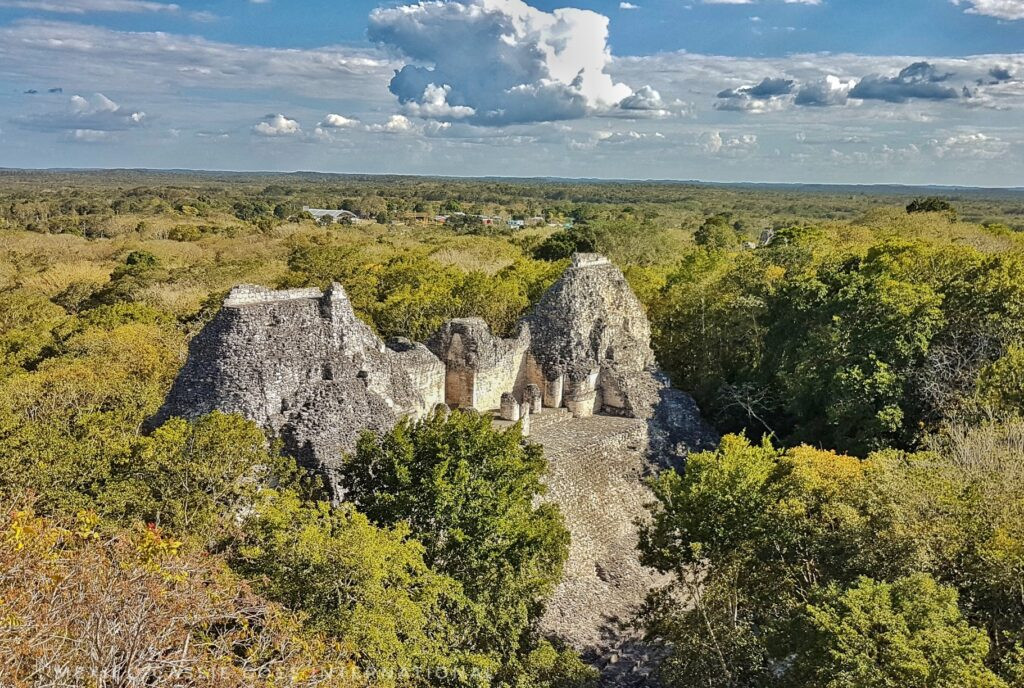 view of a maya ruin from sitting on another Maya ruin
view of a maya ruin from sitting on another Maya ruin
Image: Maya ruins near Bacalar, Mexico, inviting exploration of the region’s ancient history and archaeological wonders.
Ichkabal, the closest Maya ruin to Bacalar, may not be consistently open to the public. It’s advisable to inquire locally in Bacalar about its accessibility before planning a trip, especially considering the 1.5-hour journey and unpaved road sections.
For those interested in Maya ruins in Quintana Roo and the Yucatan Peninsula, consider these alternatives:
- Dzibanche and Kohunlich Ruins Tour: Take a tour to Dzibanche and Kohunlich Ruins for a more accessible and impressive archaeological experience.
- Yucatan Maya Ruins: Explore renowned sites like Chichén Itzá, Uxmal, and the Ruta Puuc in Yucatan state.
- Quintana Roo Maya Ruins: Discover Tulum, Cobá, and Muyil ruins closer to the coast.
- Campeche Maya Ruins: Venture west to Campeche to visit Calakmul, Becán, Chicanna, or Edzná ruins (Calakmul and Becán are top-rated ruins in the Yucatan Peninsula region).
- Palenque in Chiapas: Even Palenque in Chiapas is a possible, longer trip south from Bacalar for dedicated Maya ruin enthusiasts.
Sunflower Fields Near Bacalar: A Surprising Sight
While not native to Mexico, sunflower fields have emerged near Bacalar, reflecting the influence of social media trends. Fields are located around km 22.5 on the Reforma – Bacalar Highway at Rancho Perssa. Similar sunflower fields can also be found near Mérida.
Where to Stay in Bacalar Lagoon: Accommodation Options
Budget-Friendly: Pata de Perro Hostel and Suites is centrally located on the zocalo, within walking distance of the lagoon. It has a highly-rated hostel restaurant.
Lakeside Camping: Ecocamping Yaxche offers budget-friendly rooms and tents with lagoon access, hammocks, and swings.
5-Star Luxury in Bacalar Town: Casa Chukum offers luxury accommodations in town.
5-Star Luxury with Private Lake Access: Xoot Ka’Ana Villa Fantasia offers luxurious apartments with private lagoon access.
→ Use this interactive accommodation finder to explore more options and find accommodations to your liking.
Where to Eat in Bacalar Lagoon: Dining Recommendations
Highly recommended dining spots in Bacalar Lagoon include:
- Balneario Ejidal Magico: Offers good food in a casual setting.
- Pata de Perro: Excellent hostel restaurant with a great atmosphere.
- Los Aluxes: Enjoyable dining experience with lagoon views.
- La Playita: Popular lagoon-front restaurant with excellent cuisine (reservations essential).
- Mango Y Chile: A delicious vegetarian and vegan-friendly option.
Final Bacalar Lagoon Travel Questions Answered
Bacalar Lagoon vs. Holbox: Which Destination is Right for You?
Choosing between Bacalar Lagoon and Holbox depends on your preferences. Holbox Island is a small, idyllic island off the Yucatan coast, ideal for beach lovers.
- Beaches vs. Lagoon: If you prioritize beaches, Holbox is the better choice. If you seek a unique freshwater lagoon experience, Bacalar excels.
- Atmosphere: Both offer relaxed, laid-back vibes with luxury options available.
- Sustainability: Both destinations face over-tourism challenges. Responsible travel is crucial in both locations.
ATMs in Bacalar Lagoon: Accessing Cash
ATMs are available in Bacalar, but they can be limited and may run out of cash, especially during peak season. It’s advisable to bring sufficient cash in Mexican pesos.
Getting Married in Bacalar Lagoon: Destination Weddings
Bacalar Lagoon is an increasingly popular destination for weddings, offering stunning natural scenery. Legal same-sex marriage is permitted in Quintana Roo and throughout Mexico. Numerous wedding planners and venues in Bacalar can assist with arrangements.
Viator and other tour sites offer Bacalar wedding packages.
Final Thoughts on Bacalar Lagoon and Crocodiles
Despite initial concerns about “are there crocodiles in Bacalar Lagoon?”, Bacalar Lagoon is an incredibly safe and magical destination to visit. With its breathtaking beauty, diverse activities, and tranquil atmosphere, Bacalar promises an unforgettable Mexican Caribbean experience.
